Abstract
Perfusion of cat paws with compound 48/80 released two slow reacting substances (SRSs) which were isolated and characterized as 5-hydroxy-6-S-cysteinylglycyl-7,9,11,14-icosatetraenoic acid (SRS I) and 5-hydroxy-6-S-cysteinyl-7,9,11,14-icosatetraeonic acid (SRS II) on the basis of chemical degradations, amino acid analyses, spectroscopic and enzymic experiments, and comparison with synthetic samples. The smooth muscle-contractile activities of synthetic 5-hydroxy-6-gamma-glutamylcysteinylglycyl-7,9,11,14-icosatetraenoic acid, synthetic 5-hydroxy-6-S-cysteinyl-7,9,11,14-icosatetraenoic acid, and SRS II were not inactivated by arylsulfatase. On the other hand, the spasmogenic activities produced by synthetic 5-hydroxy-6-S-cysteinylglycyl-7,9,11,14-icosatetraenoic acid and SRS I were destroyed at the same rate by the arylsulfatase. This mode of inactivation was attributed to an aminopeptidase activity in the arylsulfatase preparation because 5-hydroxyl-6-S-cysteinyl-7,9,11,14-icosatetraenoic acid was isolated and identified as the reaction end product. Because the properties of SRS from cat paws closely resemble those of SRS generated by immunological stimulation of human tissues (SRS-A) and because all known SRS-A are inactivated by arylsulfatases, we contend that 5-hydroxy-6-S-cysteinylglycyl-7,9,11-14-icosatetraenoic acid (SRS I) corresponds to SRS-A.
Full text
PDF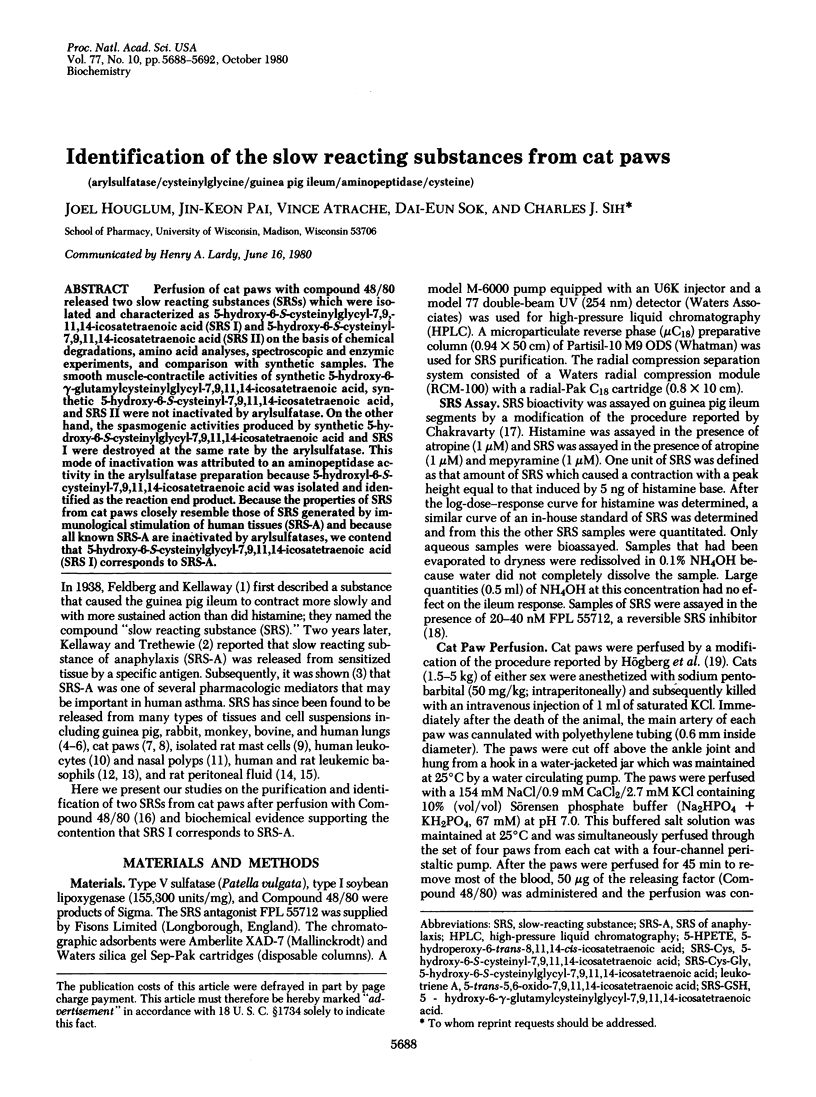
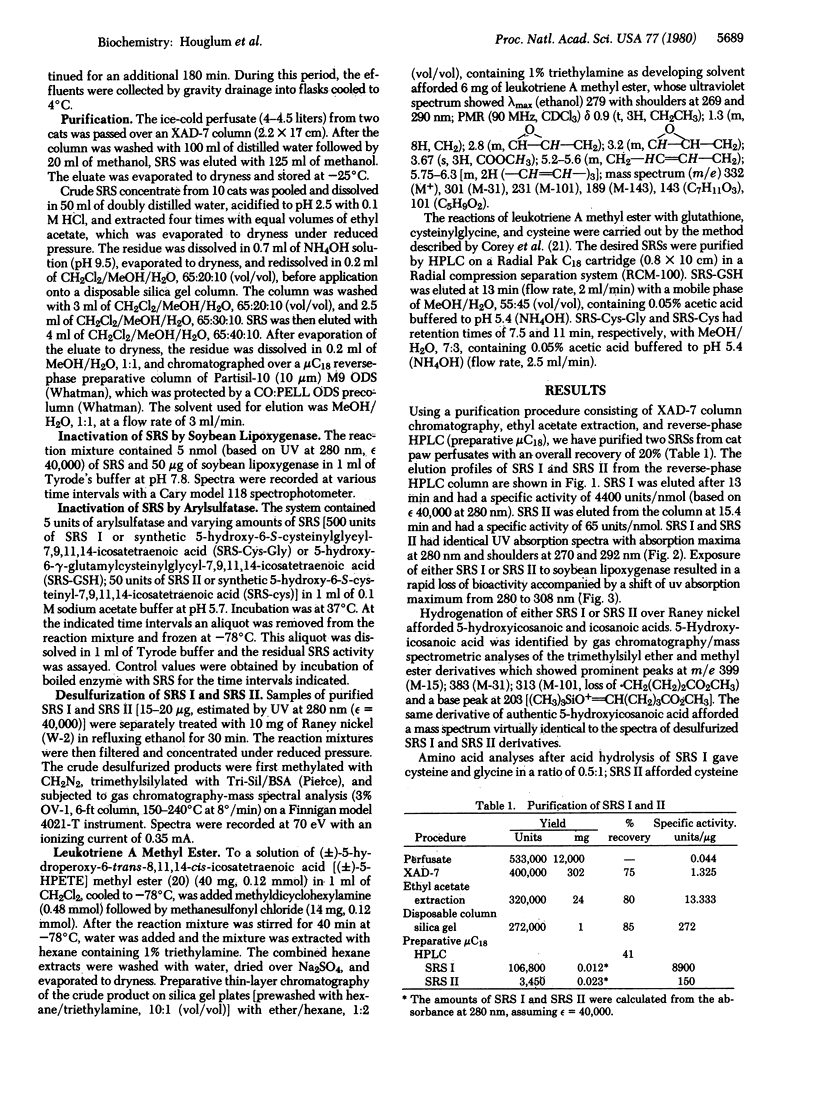
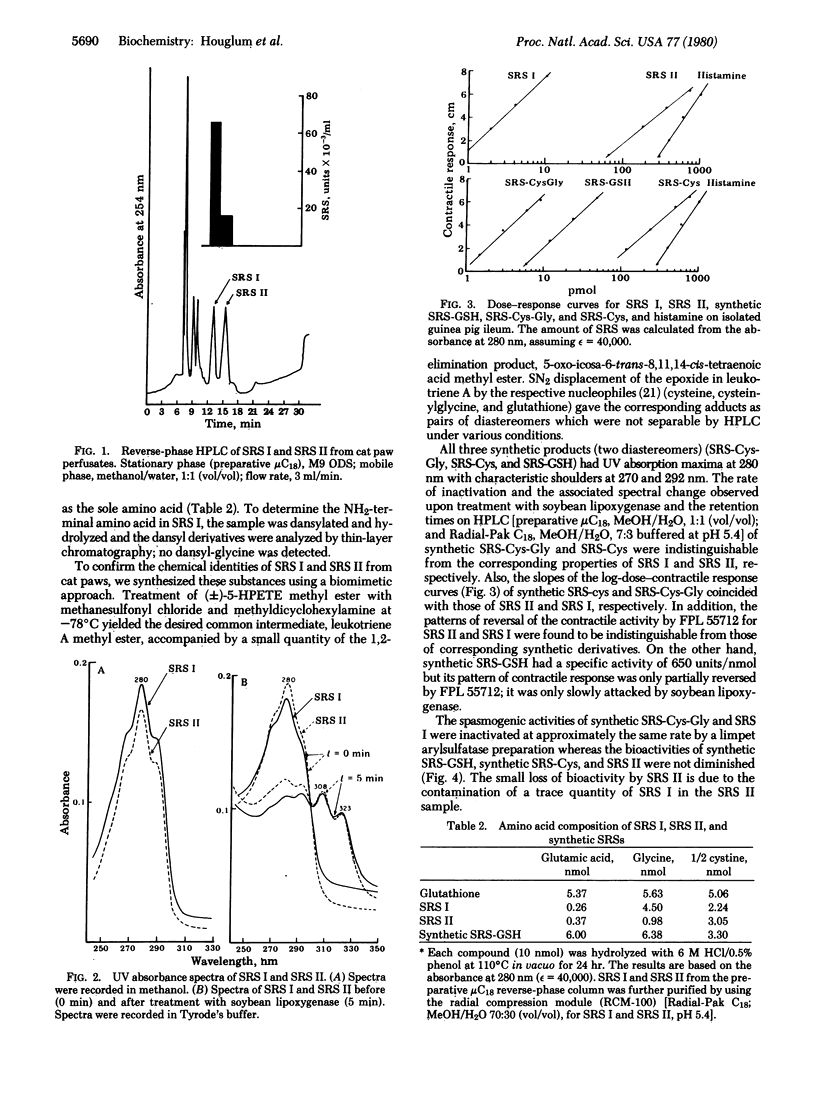
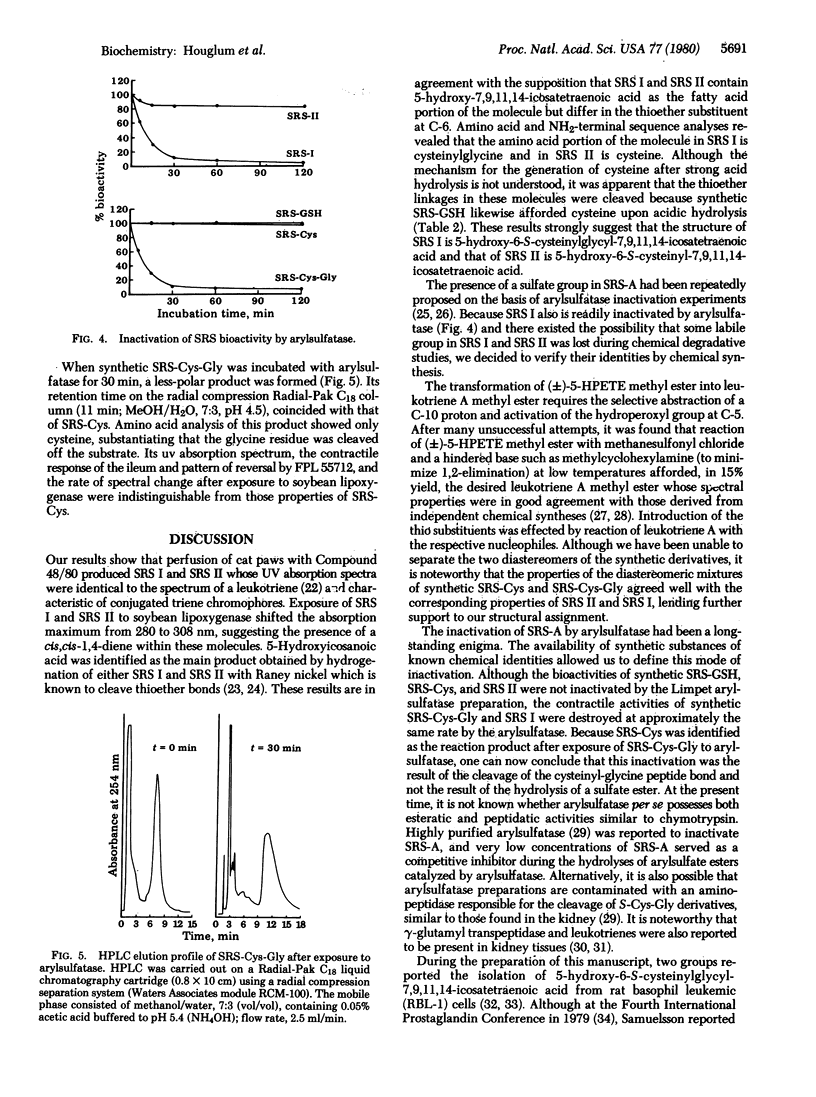
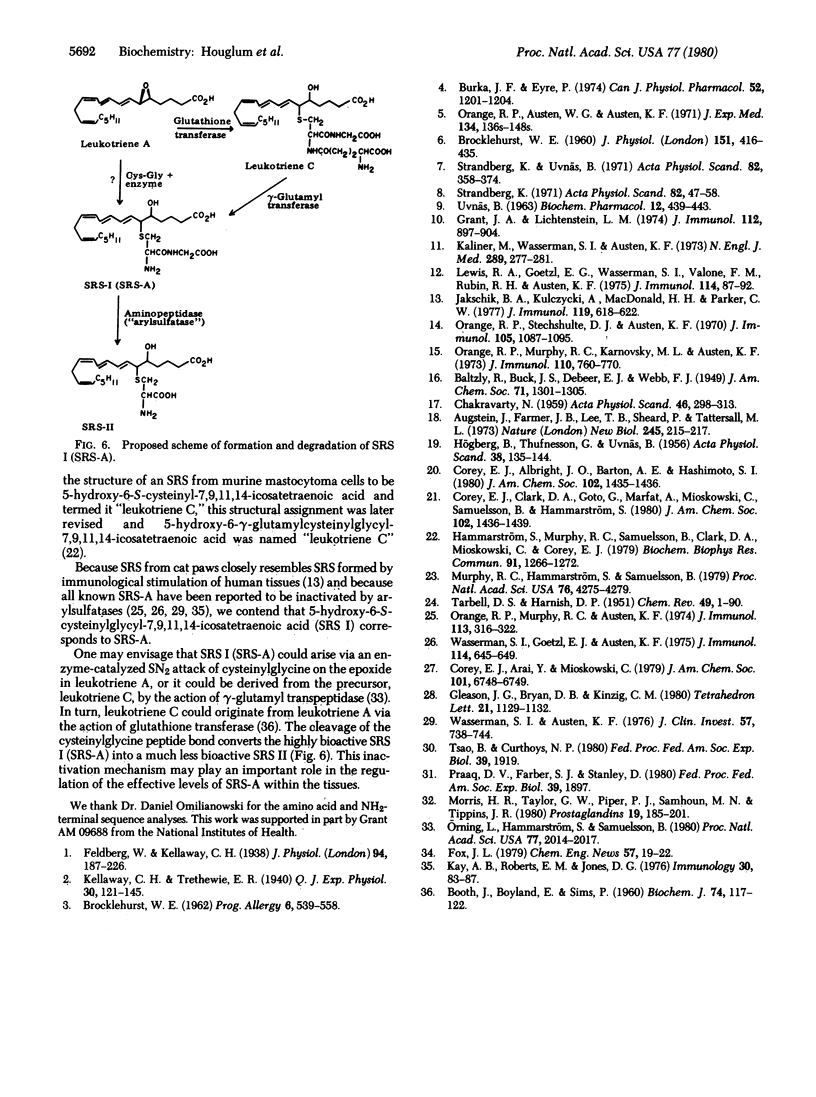
Selected References
These references are in PubMed. This may not be the complete list of references from this article.
- Augstein J., Farmer J. B., Lee T. B., Sheard P., Tattersall M. L. Selective inhibitor of slow reacting substance of anaphylaxis. Nat New Biol. 1973 Oct 17;245(146):215–217. doi: 10.1038/newbio245215a0. [DOI] [PubMed] [Google Scholar]
- BOOTH J., BOYLAND E., SIMS P. Metabolism of polycyclic compounds. 15. The conversion of naphthalene into a derivative of glutathione by rat-liver slices. Biochem J. 1960 Jan;74:117–122. doi: 10.1042/bj0740117. [DOI] [PMC free article] [PubMed] [Google Scholar]
- BROCKLEHURST W. E. Slow reacting substance and related compounds. Prog Allergy. 1962;6:539–558. [PubMed] [Google Scholar]
- BROCKLEHURST W. E. The release of histamine and formation of a slow-reacting substance (SRS-A) during anaphylactic shock. J Physiol. 1960 Jun;151:416–435. doi: 10.1113/jphysiol.1960.sp006449. [DOI] [PMC free article] [PubMed] [Google Scholar]
- Burka J. F., Eyre P. The immunological release of slow-reacting substance of anaphylaxis from bovine lung. Can J Physiol Pharmacol. 1974 Dec;52(6):1201–1204. doi: 10.1139/y74-156. [DOI] [PubMed] [Google Scholar]
- CHAKRAVARTY N. A method for the assay of 'slow reacting substance'. Acta Physiol Scand. 1959 Aug 31;46:298–313. doi: 10.1111/j.1748-1716.1959.tb01760.x. [DOI] [PubMed] [Google Scholar]
- Feldberg W., Kellaway C. H. Liberation of histamine and formation of lysocithin-like substances by cobra venom. J Physiol. 1938 Nov 14;94(2):187–226. doi: 10.1113/jphysiol.1938.sp003674. [DOI] [PMC free article] [PubMed] [Google Scholar]
- Grant J. A., Lichtenstein L. M. Release of slow reacting substance of anaphylaxis from human leukocytes. J Immunol. 1974 Mar;112(3):897–904. [PubMed] [Google Scholar]
- HOGBERG B., THUFVESSON G., UVNAS B. Histamine liberation produced in the perfused paw of the cat by 48/80 and extracts from jellyfish (Cyanea capillata) and eelworm (Ascaris lumbricoides) from swine. Acta Physiol Scand. 1956 Dec 31;38(2):135–144. doi: 10.1111/j.1748-1716.1957.tb01389.x. [DOI] [PubMed] [Google Scholar]
- Hammarström S., Murphy R. C., Samuelsson B., Clark D. A., Mioskowski C., Corey E. J. Structure of leukotriene C. Identification of the amino acid part. Biochem Biophys Res Commun. 1979 Dec 28;91(4):1266–1272. doi: 10.1016/0006-291x(79)91203-8. [DOI] [PubMed] [Google Scholar]
- Jakschik B. A., Kulczycki A., Jr, MacDonald H. H., Parker C. W. Release of slow reacting substance (SRS) from rat basophilic leukemia (RBL-1) cells. J Immunol. 1977 Aug;119(2):618–622. [PubMed] [Google Scholar]
- Kaliner M., Wasserman S. I., Austen K. F. Immunologic release of chemical mediators from human nasal polyps. N Engl J Med. 1973 Aug 9;289(6):277–281. doi: 10.1056/NEJM197308092890601. [DOI] [PubMed] [Google Scholar]
- Kay A. B., Roberts E. M., Jones D. G. Tissue inactivation of slow reacting substance of anaphylaxis. Immunology. 1976 Jan;30(1):83–87. [PMC free article] [PubMed] [Google Scholar]
- Lewis R. A., Goetzl E. J., Wasserman S. I., Valone F. H., Rubin R. H., Austen K. F. The release of four mediators of immediate hypersensitivity from human leukemic basophils. J Immunol. 1975 Jan;114(1 Pt 1):87–92. [PubMed] [Google Scholar]
- Morris H. R., Taylor G. W., Piper P. J., Samhoun M. N., Tippins J. R. Slow reacting substances (SRSs): the structure identification of SRSs from rat basophil leukaemia (RBL-1) cells. Prostaglandins. 1980 Feb;19(2):185–201. doi: 10.1016/0090-6980(80)90019-2. [DOI] [PubMed] [Google Scholar]
- Murphy R. C., Hammarström S., Samuelsson B. Leukotriene C: a slow-reacting substance from murine mastocytoma cells. Proc Natl Acad Sci U S A. 1979 Sep;76(9):4275–4279. doi: 10.1073/pnas.76.9.4275. [DOI] [PMC free article] [PubMed] [Google Scholar]
- Orange R. P., Austen W. G., Austen K. F. Immunological release of histamine and slow-reacting substance of anaphylaxis from human lung. I. Modulation by agents influencing cellular levels of cyclic 3',5'-adenosine monophosphate. J Exp Med. 1971 Sep 1;134(3 Pt 2):136s–148s. [PubMed] [Google Scholar]
- Orange R. P., Murphy R. C., Austen K. F. Inactivation of slow reacting substance of anaphylaxins (SRS-A) by arylsulfatases. J Immunol. 1974 Jul;113(1):316–322. [PubMed] [Google Scholar]
- Orange R. P., Murphy R. C., Karnovsky M. L., Austen K. F. The physicochemical characteristics and purification of slow-reacting substance of anaphylaxis. J Immunol. 1973 Mar;110(3):760–770. [PubMed] [Google Scholar]
- Orange R. P., Stechschulte D. J., Austen K. F. Immunochemical and biologic properties of rat IgE. II. Capacity to mediate the immunologic releas of histamine an slow-reacting substance of anaphylaxis (SRS-A). J Immunol. 1970 Nov;105(5):1087–1095. [PubMed] [Google Scholar]
- Orning L., Hammarström S., Samuelsson B. Leukotriene D: a slow reacting substance from rat basophilic leukemia cells. Proc Natl Acad Sci U S A. 1980 Apr;77(4):2014–2017. doi: 10.1073/pnas.77.4.2014. [DOI] [PMC free article] [PubMed] [Google Scholar]
- Strandberg K. Release of histamine and formation of slow reacting substance in the cat paw induced by compound 48-80. Acta Physiol Scand. 1971 May;82(1):47–58. doi: 10.1111/j.1748-1716.1971.tb04941.x. [DOI] [PubMed] [Google Scholar]
- Strandberg K., Uvnäs B. Purification and properties of the slow reacting substance formed in the cat paw perfused with compound 48-80. Acta Physiol Scand. 1971 Jul;82(3):358–374. doi: 10.1111/j.1748-1716.1971.tb04977.x. [DOI] [PubMed] [Google Scholar]
- UVNAS B. Lipid spasmogens appearing in connection with histamine liberation. Biochem Pharmacol. 1963 Apr;12:439–443. doi: 10.1016/0006-2952(63)90079-0. [DOI] [PubMed] [Google Scholar]
- Wasserman S. I., Austen K. F. Arylsulfatase B of human lung. Isolation, characterization, and interaction with slow-reacting substance of anaphylaxis. J Clin Invest. 1976 Mar;57(3):738–744. doi: 10.1172/JCI108332. [DOI] [PMC free article] [PubMed] [Google Scholar]
- Wasserman S. I., Goetzl E. J., Austen K. F. Inactivation of slow reacting substance of anaphylaxis by human eosinophil arylsulfatase. J Immunol. 1975 Feb;114(2 Pt 1):645–649. [PubMed] [Google Scholar]


